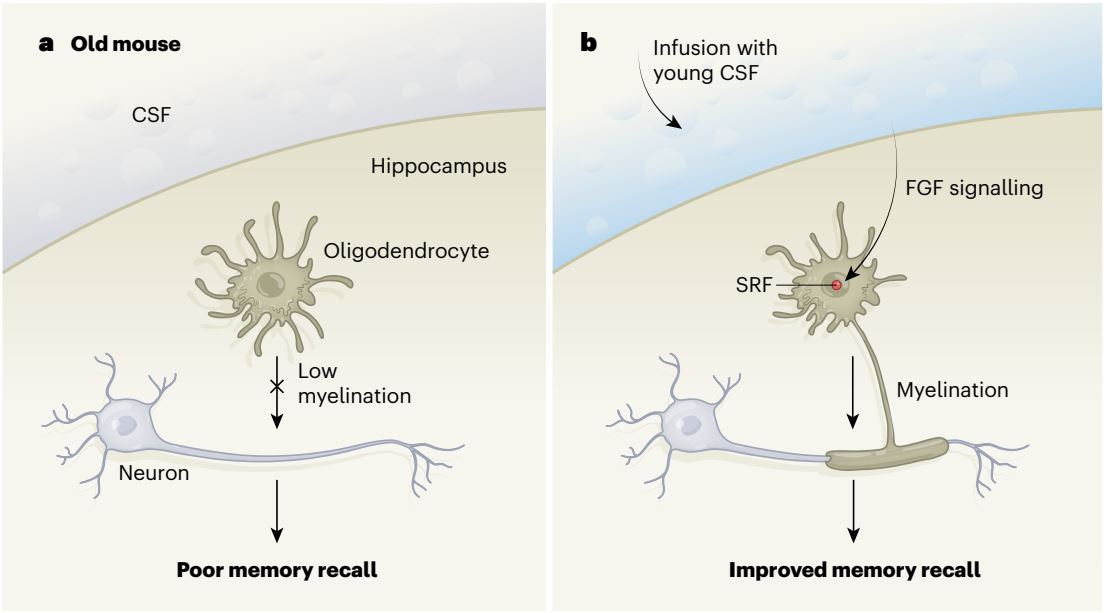
Posted on 05/11/2022 9:15:57 AM PDT by Red Badger
While immortality might forever be out of reach, a long, healthy retirement is the stuff dreams are made of.
To that end, a recent study suggests that the kinds of memory problems common in old age can be reversed, and all it takes is some cerebrospinal fluid harvested from the young. In mice, at least.
If this is sounding a little familiar, you might be thinking of a similar series of studies done back in the mid-2010s, which found that older mice could be generally 'rejuvenated' with the blood of younger animals – both from humans and from mice. The FDA even had to warn people to stop doing it.
This new study instead examined the links between memory and cerebrospinal fluid fluid (CSF), and the results show considerable promise, even providing a mechanism for how it works, and highlighting a potential growth factor that could mimic the results.
"We know that CSF composition changes with age, and, in fact, these changes are used routinely in the clinic to assess brain health and disease biomarkers," Stanford University neurologist Tal Iram told ScienceAlert.
"However, we don't know well how these changes affect the function of the cells in the aging brain."
To investigate, the researchers, led by Iram, took older mice (between 18–22 months old) and gave them light shocks on the foot, at the same time as a tone and flashing light were activated. The mice were then split into groups, and either given young mouse CSF (from animals 10 weeks old) or artificial CSF.
In experiments like this, if the mice 'freeze' when they see the tone and light, it means they're remembering the foot shock, and are preparing for it to happen again.
In this study, three weeks after the foot shocks were conducted (which the team called "memory acquisition"), the researchers tested the mice, finding that the animals that had been given the CSF from young mice showed higher-than-average freezing rates, suggesting they had better memory.
This was followed up by a battery of other experiments to test the theory, which revealed that certain genes (that are different in young-versus-old CSF) could be used to get the same response. In other words, without needing to extract someone's brain fluid.
"When we took a deeper look into gene changes that occurred in the hippocampus (a region associated with memory and aging-related cognitive decline), we found, to our surprise, a strong signature of genes that belong to oligodendrocytes," Iram told ScienceAlert.
"Oligodendrocytes are unique because their progenitors are still present in vast numbers in the aged brain, but they are very slow in responding to cues that promote their differentiation. We found that when they are re-exposed to young CSF, they proliferate and produce more myelin in the hippocampus."
In the mice, an infusion of a fibroblast growth factor called FGF17 was able to boost oligodendrocyte progenitor cells in a similar way to the CSF injection.
Oligodendrocytes are particularly helpful because they produce myelin, a material that covers and insulates neuron fibers. The infusion of FGF17 was itself able to help the older mice increase memory ability.
A diagram showing the results in the cell. (Nature)
While this field of research has a very very long way to go before we can use such insights to increase memory in older humans, the findings are exciting, and hopefully future studies following these leads can help us live out our retirement without having to resort to the body fluids of young whippersnappers.
"Iram and colleagues have broken ground in the field of brain health and aging by discovering that young CSF contains a factor that aids memory recall in older mice," write researchers Miriam Zawadzki & Maria K. Lehtinen from Boston Children's Hospital in an accompanying News and Views piece.
"Not only does the study imply that FGF17 has potential as a therapeutic target, but it also suggests that routes of drug administration that allow therapeutics to directly access the CSF could be beneficial in treating dementia. Any such treatments will be hugely helpful in supporting our aging population."
The research has been published in Nature.
Isn’t this the same daily baby juice shake that all old rich democrats use already?
It sounds familiar because of Q and others stating that is why leadership types want aborted babies.
I guess this explains Soros...
Liberal vampires like Bill Gates will find this welcome news.
Paging Mr. Biden....Mr. President? We have something for you.
But, did the old mice suddenly get an urge to do body piercing and social messenging?
I believe that because of this the fate of many babies, both born and un-born, is perilous and has been for much longer than we think. It’s too ugly to even think about.
He already has a mouse brain, he doesn't need an injection.
Maybe wokeness is really to stifle brain activity in the young to keep their fluid fresher.
Cartoon Vampire Mice, old and angry, using a crooked cane, wrapped in a black cape, living in a castle.
“Isn’t this the same daily baby juice shake that all old rich democrats use already?”
The PP Abortion Clinics are the main supplier; it’s likely a big profit center? Asking for a friend...
smarter, faster, healthier mice are what the world really needs.

Demonic.

Last week they we’re injecting the older mice with younger mouse poop to stop the aging process, now their using brain cells?
Sh!+ for brains scientists.
This must be what Brandon is doing.
Disclaimer: Opinions posted on Free Republic are those of the individual posters and do not necessarily represent the opinion of Free Republic or its management. All materials posted herein are protected by copyright law and the exemption for fair use of copyrighted works.